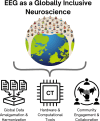Electroencephalography (EEG) and the Quest for an Inclusive and Global Neuroscience
- PMID: 40103341
- PMCID: PMC11920675
- DOI: 10.1111/ejn.70078
Electroencephalography (EEG) and the Quest for an Inclusive and Global Neuroscience
Abstract
The current lack of diversity in neuroimaging datasets limits the potential generalisability of research findings. This situation is also likely to have a downstream impact on our ability to translate fundamental research into effective interventions and treatments for the global population. We propose that electroencephalography (EEG) is viable for delivering truly inclusive and global neuroscience. Over the past two decades, advances in portability, affordability, and computational sophistication have created a tool that can readily reach underrepresented communities and scale across low-resource contexts-advantages that surpass those of other neuroimaging modalities. However, skepticism persists within the neuroscience community regarding the feasibility of realizing EEG's full potential for studying the brain on a global scale shortly. We highlight several challenges impeding progress, including the need to amalgamate large-scale, harmonized datasets to provide the statistical power and robust computational frameworks necessary for examining subtle differences between populations; the advancement of EEG technology to ensure high-quality data acquisition from all individuals-irrespective of hair type-and operable by nonspecialists; and the importance of engaging directly with communities to cocreate culturally sensitive and ethically appropriate research methodologies. By tackling these technical and social challenges and building on initiatives dedicated to inclusivity and collaboration, we can harness EEG's potential to deliver neuroscience genuinely representative of the global population.
Keywords: community engagement; data harmonization; electroencephalography (EEG); global neuroimaging; inclusivity.
© 2025 The Author(s). European Journal of Neuroscience published by Federation of European Neuroscience Societies and John Wiley & Sons Ltd.
Conflict of interest statement
The authors declare no conflicts of interest.
Figures

Similar articles
-
14 challenges and their solutions for conducting social neuroscience and longitudinal EEG research with infants.Infant Behav Dev. 2020 Feb;58:101393. doi: 10.1016/j.infbeh.2019.101393. Epub 2019 Dec 9. Infant Behav Dev. 2020. PMID: 31830682 Review.
-
Electroencephalography.Curr Biol. 2019 Feb 4;29(3):R80-R85. doi: 10.1016/j.cub.2018.11.052. Curr Biol. 2019. PMID: 30721678
-
Non-invasive canine electroencephalography (EEG): a systematic review.BMC Vet Res. 2025 Feb 18;21(1):73. doi: 10.1186/s12917-025-04523-3. BMC Vet Res. 2025. PMID: 39966923 Free PMC article.
-
Integrative neuroscience: the role of a standardized database.Clin EEG Neurosci. 2005 Apr;36(2):64-75. doi: 10.1177/155005940503600205. Clin EEG Neurosci. 2005. PMID: 15999901 Review.
-
Present and future of simultaneous EEG-fMRI.MAGMA. 2010 Dec;23(5-6):309-16. doi: 10.1007/s10334-009-0196-9. Epub 2010 Jan 26. MAGMA. 2010. PMID: 20101434 Review.
References
MeSH terms
Grants and funding
- BB/X008428/1/UK Research and Innovation Biotechnology and Biological Sciences Research Council
- NIHR203331/National Institute for Health and Care Research (NIHR) Leeds Biomedical Research Centre
- 1210195/CONICET
- 1210176/CONICET
- 1220995/CONICET
- ANID/FONDECYT Regular
- 15150012/ANID/FONDAP
- ACT210096/ANID/PIA/ANILLOS
- ID20I10152/FONDEF
- CW2680521/Takeda Pharmaceutical Company
- AG075775/Fogarty International Center (FIC), National Institutes of Health, National Institutes of Ageing
- AG057234/Fogarty International Center (FIC), National Institutes of Health, National Institutes of Ageing
- AG082056/Fogarty International Center (FIC), National Institutes of Health, National Institutes of Ageing
- AG083799/Fogarty International Center (FIC), National Institutes of Health, National Institutes of Ageing
- CARDS-NIH 75N95022C00031/Fogarty International Center (FIC), National Institutes of Health, National Institutes of Ageing
- SG-20-725707/ALZ/Alzheimer's Association/United States
- Rainwater Charitable Foundation - The Bluefield Project to Cure FTD
- Global Brain Health Institute
LinkOut - more resources
Full Text Sources
Miscellaneous

